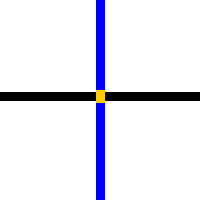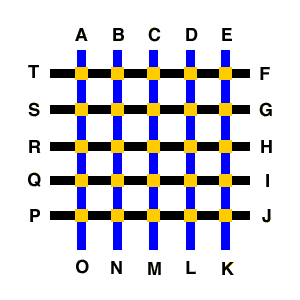Project Description
For this project, you will use LEGO Mindstorms robots and the NQC
programming language to program a robot that can navigate around
a grid.
The grid will be composed of segments that look like this:
|
The full course will look like this:
|
0 < black < blue < white < gold < 100
You will write a program for a robot that can follow a blue or black line and can keep count of how many gold intersections it crosses, so that we could give it a task, say of starting at point A and ending at point J, and the robot would know how to complete this task.
The robot needs to be able to complete the following tasks:
- Go from any one point to another given point, on an empty
course free of obstacles.
- Find its way from any one point to another, on a course that has
obstacles on it so that some of the intersections are blocked--meaning
that the robot must backtrack in order to complete the route.
- Find the SHORTEST way from any one point to another, on a course that has obstacles on it so that some of the intersections are blocked--meaning that the robot must employ a search algorithm in order to determine the shortest route. Once the route has been determined, presumably by the robot following a search path from the starting point that includes backtracking to get to the ending point, the robot should then return to the starting point (from the ending point) by following the shortest path (in reverse, obviously).